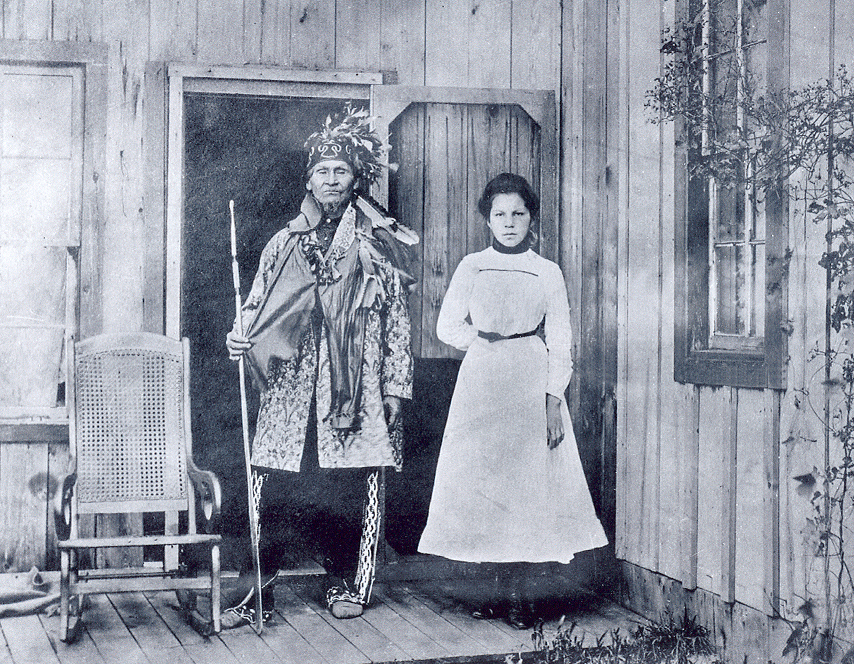Editor’s Note: This is the first of a series of two stories written by Jim Smith. Jim passed away Sept. 18. Jim’s historical stories about Grayling and Crawford County have entertained, informed and educated readers of Up North Voice for many years. He will be missed.
– Mark
GRAYLING – In these difficult times it’s hard not to wish for a return to the “Good Old Days”, when a handshake meant something, when the difference between right and wrong was not blurred into so many shades of gray, and when a man’s word was as good as any written contract.
Life was slower and a man could catch his breath between crisis. There was time to do a little huntin’ or fishin” or enjoy a cup of coffee with your neighbor. Life was “face to face”.

Crawford County used to be like that. Yes, there are still small pockets of intimate friends where relationships like this still exist but more and more we are being separated by smart phones, computers and automatic answering machines where our personalities are reduced to some numbers in a data base.
In the past information was either delivered in person or by written words. (Does anyone even remember what cursive is?) The first newspaper in Crawford County was the Avalanche. The first issue was published in May of 1879 under the management of George Maurer of Mt. Pleasant, Michigan.

Timber was the key to the opening of Northern Michigan.
The first railway into Crawford county was the Jackson, Lansing & Saginaw. Grayling, originally named Crawford Junction, was platted by the railroad in 1873 when the line was built to Gaylord. Grayling was the main division between Bay City and Mackinaw City where the trains changed crews.
As the logging industry grew, dozens of spur lines were built to feed the logs or finished lumber into the main line for transport to market. Being the County Seat and the main shipping point for much of the logging industry, Grayling enjoyed being “First” in many things in Michigan’s North Country.

Originally the early settlers had to “live off the land”. Hunting and fishing provided the protein necessary to maintain the hard, outdoor life. Gardens were a necessity for growing crops that could readily be stored to provide the vitamin sources required by the long dark winters. It was not uncommon for hunters to harvest game far in excess of what today’s game laws allow.
Most everyone is familiar with the story of Grayling’s name sake, the Grayling fish. Not a trout but a member of the Arctic Char family, the fish is distinguished by the sail-like dorsal fin.

The logging industry and change of habitat were mostly responsible for the extinction of the fish in Michigan’s waters but we must add over-fishing as one of the extinction factors. There are records of thousands of Grayling being shipped to Chicago and Detroit in refrigerated railway cars.

The same was true for most wildlife, deer, ducks, and other game species harvested in northern Michigan and considered delicacies in the major metropolitan cities of north central and eastern United States.
In 1873, Rube Babbitt moved to the Grayling area at the age of 14. Over the following years Rube became one of the better respected guides on the river and eventually the first Game Warden appointed in Northern Michigan. As a life-long friend of David Shoppenagon, Rube worked to introduce the Brook Trout into the niche left when the Grayling died out. His support of this effort was one of the factors that led to the establishment of the first Fish Hatchery of the state of Michigan.

As Grayling grew it constantly presented new opportunities to investors and new businessmen. One of the first power generating stations was erected to electrify the City and surrounding area. Grayling investors sold stock on the open market that funded a telephone company.
In 1927 Karen Hartwick donated 85 acres to the State to develop and hold as a memorial to her husband who died in France in WW I. In 1935 and 1936 the CCC men built the original log structure which still stands as a museum to represent the logging days in Michigan. This was one of the first state parks in Michigan.

The Michigan logging industry was the first to utilize the log mover called “Big Wheels”. “Big Wheels” was invented in 1875 by Silas Overpack in Manistee, Michigan and was soon integrated into logging operations nation-wide. The Big Wheels could move logs from 12 feet long to 100 feet long over boggy soil that mire down a regular wagon and allowed lumbermen to transport logs year-round.
Another “First” for Grayling developed when Esbern Hanson partnered with Frank Ahman to open an auto repair shop and the first Ford Dealership in the area. This happened around 1928.

Also in 1929 the Grayling Winter Sports Park was opened. It was originally a toboggan run that, by 1934, grew to be Michigan’s first ski area with a 66-foot ski jump. Over the years the park events developed into a Winter Carnival with a Snow Queen, an ice sculpture competition and parades. The event became so popular that a Snow Train was started to transport skiers from all over the state.
Skiers were hauled from Grayling lodges to the Winter Sports Park on flat-bed trucks. The Winter Sports Park has grown to be a prime destination for family ski trips during the winter. It has snowshoe trails and cross-country ski facilities. Fall and spring events are also very popular.
No list of “Firsts” would be complete without the mention of Fred Bear and the Bear Archery Company.
Fred Bear and Charles Piper started Bear Products in 1933 as a company providing advertising support to the automotive industry. Fred became fascinated by archery and decided to try manufacturing his own bows.
To that end he hired Nels Grumley,in 1938, to design a line of bows to be sold under the “Bear” name. Fred was fascinated by modern manufacturing methods and patented a process called “Glass Power”. Nels was more interested in finely-crafted, hand-made bows. This led to a parting of the ways between in 1948 between Fred and Nels.. Shortly thereafter, Fred built and opened a new factory in Grayling.
Fred traveled the world hunting with a bow and making films about his adventures. More than anything else, Fred’s adventures brought the world of archery from the sidelines into a product name recognized world-wide.
Perhaps the best known “First” for Grayling and Crawford County is the AuSable River Canoe Marathon. For 47 years canoe racing enthusiasts have descended on Grayling the last Saturday in July to compete in, what is considered to be, the “Oldest Canoe Marathon in the United States.
The birth of the marathon can be traced back to Harold “Spike” MacNeven who, with several other local merchants, organized a canoe carnival weekend, as a way to promote Grayling. This 1932 weekend culminated in a 50-mile canoe race down the AuSable. Each river guide who provided a boat was paid $1 and every boat in the county was used, including rowboats. (Sadly this year the Marathon had to be canceled because of the Pandemic.). That first event attracted, with help from the Bay City Times, 105 spectators.
The first AuSable River Canoe Marathon was held in 1947. It has been billed as the “world’s toughest spectator sport”. The Marathon has become the third leg in the “Triple Crown of Canoe Racing”. The other two legs are run in upper New York state and Ontario, Canada.
The number of “Firsts” that make up the history of Grayling and Crawford County is overwhelming, especially for a former lumber town planted in the very center of Northern Michigan. These are just a few ”Firsts” to whet the readers appetite. All these events are well documented within the walls of the Crawford County Museum.
Again, because of the Covid-19 pandemic the Museum has been unable to open this year.
Despite being closed to the public, the work goes on. New displays are being completed. If our fund raising efforts succeed, we will soon have the extra few dollars required to complete the new agriculture addition. Either way the Museum plans on opening in the spring of 2001 and continuing to share Crawford County’s history with all our visitors.


